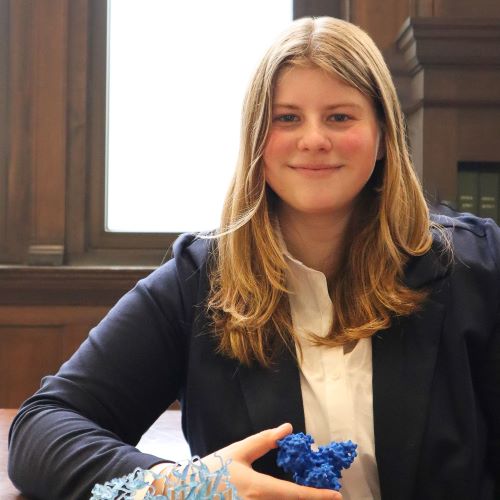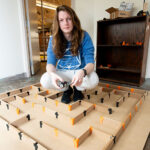
Medical relevance and foundational biochemical research skills combine in I.S. project

Field hockey brought Zoë Semersky ’23 to The College of Wooster as a freshman recruit. On the field as a collegiate field hockey goalkeeper, she learned grit, which transferred perfectly to the classroom and scientific research as she studied biochemistry and molecular biology. Through discipline, adaptability, and the ability to enjoy the scientific journey by staying curious, she was fueled for new learning opportunities. She took that same attitude into her Independent Study, focused on an aspect of neurodegenerative diseases like Alzheimer’s and Parkinson’s diseases. The facet she studied, metal ion dyshomeostatis, involves an imbalance in the brain of metal ions such as copper and iron. One of the characteristics of these disease states is the depletion of norepinephrine, a neurotransmitter in the brain involved in learning and memory processes, as well as others.
“With some benchwork under my belt, an insatiable curiosity about what makes life tick on a molecular level, and the coursework to bring it all together, I was confident that I was prepared for this research.”
—Zoë Semersky ’23, Biochemistry and Molecular Biology major, I.S. title: Toward a Comprehensive Framework for Investigating Copper Dyshomeostasis: The Role of His-Tag Modularity and Alternative Expression Systems in Evaluating Dopamine β-Hydroxylase
The specific focus of Semersky’s project was the molecular machinery responsible for producing norepinephrine, a protein called Dopamine β-Hydroxylase (DBH). Because the protein requires copper for its activity, understanding how variable copper levels influence DBH’s production of norepinephrine can provide experimental insight into norepinephrine loss seen in disease states clinically.
She became involved in the project after being tapped in Spring 2022 as the first and founding member of the lab of Annastassia Gallo, assistant professor of chemistry. Semersky, whose job was to help get the lab running, was involved in everything from bench organization to performing assays. “This independence is a privilege built by my prior research experience; it enhanced my confidence to plan, adapt, problem-solve, and articulate my findings critical to a research career,” she said. “I am grateful for the trust that my advisor Dr. Gallo and other faculty placed in me for this undertaking.”
Semersky was drawn to Gallo’s research because of the opportunity to combine medical relevance with foundational biochemical research skills. As a biochemistry and molecular biology major, Semersky enjoyed working with enzymes. The metal-dependent aspect of the bioinorganic chemistry lab was a bonus that she didn’t anticipate. She also was excited to be involved knowing that it may someday shape translational neurodegenerative disease work.
Though she didn’t get as far into her initial research question as she had hoped, the work she did for her I.S. set the foundations for the Gallo lab and established a clear trajectory for how to approach DBH work and assess metal ion dyshomeostatis in the future. “Science never tends to progress as you would expect, but that is just the nature of research,” she said.
Semersky became a student leader after she excelled in the introductory science coursework and built a fundamental base for a biochemistry and molecular biology degree. Her curiosity drove her to learn more, which led to an enzymology lab assistant position for Mark Snider, Robert E. Wilson Professor of Chemistry, and biochemistry and molecular biology co-chair. In Snider’s lab, she discovered the immediate translation of coursework knowledge, acquired practical lab skills, and gained an immense appreciation for the precision of biochemical work and the mindset necessary for research.
“Learning how the concepts amalgamated into something unique was eye-opening,” she said. “With some benchwork under my belt, an insatiable curiosity about what makes life tick on a molecular level, and the coursework to bring it all together, I was confident that I was prepared for this research.”
During her time at Wooster, many of Semersky’s ideas were sparked by interactions outside biochemistry, she said. One example was printed 3-D models of DBH. She worked with Caitlyn Deeter and Amelia Mitchell in Education Technology to create the models to show people what DBH looks like. The models were well-received during a poster presentation at an American Chemical Society conference and as a conversation starter when students stop into Gallo’s office. Additionally, a question Semersky had about x-ray fluorescence led to a collaboration between the lab and Meagen Pollock, professor and co-chair of earth sciences.
After graduating from Wooster in May 2023, Semersky will enter the integrated program in biochemistry at the University of Wisconsin-Madison in fall 2023 to pursue a doctorate in biochemistry.
Posted in Independent Study on May 11, 2023.
Related Posts
Related Areas of Study
Biochemistry & Molecular Biology
Biology and Chemistry combine in an interdisciplinary program for students with a passion for molecular events.
Major

